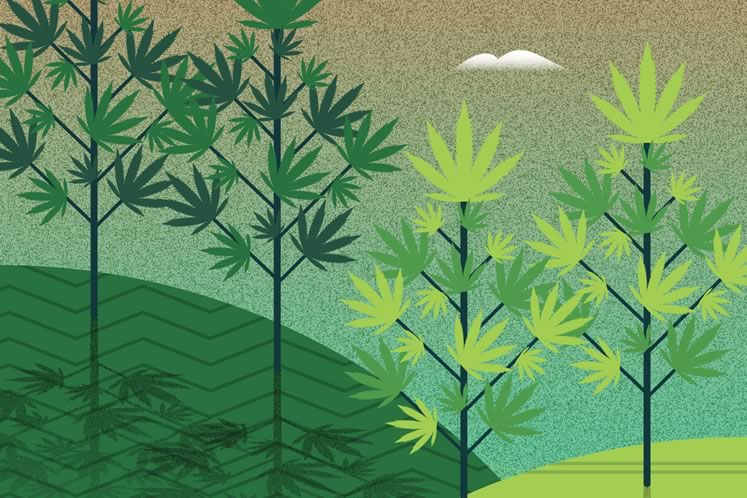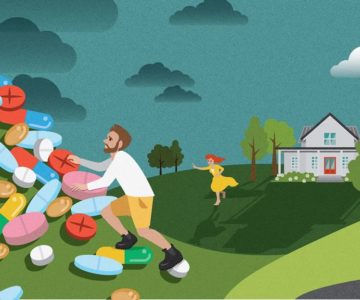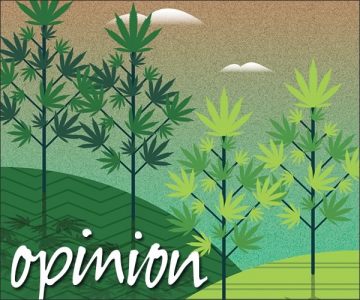Legal Cannabis in Headwaters
A year after cannabis was legalized, local residents and businesses are still trying to sort it all out.
When the recreational use of cannabis became legal last fall, a retired Caledon resident was among those who thought it might be time to give it another try. “Gone were the days when my wife and I waited till the kids were in bed before we could sneak out behind the barn for a bit of weed!” Ken* says. But he’d received advice that the once-illegal plant might help alleviate arthritic pain in his knees. The pain had never been severe enough to seek medical marijuana, but now, why not?
Alas, he says figuring out the right product to try and at what dose has eluded him. There are no locally approved cannabis retail shops and DIY online research can be spotty at best. “I can’t find a legal source – or perhaps more important – useful, reliable advice on how to use it. So for me, at this point, legalization is a joke.”
The Cannabis Act came into force on October 17, 2018, after years of promises and general public enthusiasm for the idea. Prime Minister Justin Trudeau’s plan was to legalize – and tax and regulate – what was already a widely used substance in this country. The groundbreaking move made Canada the first G7 country in the world to authorize the production and sale of cannabis for adult use (in Ontario that means 19 and older). Medical marijuana has been legal since 2001.
Canadians can now buy legal dried or fresh cannabis and edible cannabis oils from authorized sources. You are now allowed to possess in public up to a total of 30 grams of either of the two major compounds found in cannabis. The first is tetrahydrocannabinol (THC), the ingredient most associated with cannabis. It stimulates cells in the brain to release psychoactive agents. The second is cannabidiol (CBD), the non-addictive compound found in the resinous flower of cannabis. (There’s no limit to how much you can possess at home.) Edibles, extracts and topical products are poised to hit the market late this year or early 2020.
The government’s priorities included eliminating the illegal market, creating a system in which the plant could be controlled, tested and traceable, and protecting children and youth. For potential consumers like Ken, however, that means a lot of fine print on labels about the strains, volume and percentages of CBD and THC, yet almost no branding or marketing around how to start using – heck, even enjoying – the product.
Ken’s experience is just one of the many consequences of cannabis’ long road to redemption. As the landscape continues to evolve in Headwaters, here’s what we’re learning about how legal marijuana is rolling out in our communities.
Are we embracing the stuff?
As legalization took root across the country, abstainers and cannabis users alike told pollsters their habits weren’t likely to change. Right after legalization, about 15 per cent of Canadians aged 15 or older reported using cannabis in the previous three months, similar to the percentage before legalization.
In a report issued this past August, it turns out only one group, seniors 65-plus, showed a long-term bump in new usage. If Ken, 79, does manage to find a source and feel comfortable trying it out, he will fit right in. Before legalization, 3 per cent of his demographic reported using cannabis products. Now 5 per cent do. According to Statistics Canada census data, a total of 19,550 people aged 65 to 100 (and older) live in Dufferin, Caledon and Erin combined, so that uptick represents about 400 people. In other words, it’s hardly been reefer madness in these hills.
On top of that, in Ontario in general and Headwaters in particular, the retail rollout has been glacial. The only available online retailer, the Ontario Cannabis Shop, was flooded with business on the day the new legislation was enacted last year, selling out of many products. It wasn’t until April 2019 that shoppers could browse in a bricks and mortar shop in the province, due to a shift in plans by the provincial Conservatives after they won the June 2018 election. Under the previous Liberal plan, cannabis stores were to be run by an arm of the LCBO, but the new government turned the operation over to the private sector, inviting potential operators who had a proposed location to participate in an “expression of interest lottery.”
Ontario eventually approved 25 shops, but it has taken months for many of them to open their doors. The province just announced 42 new operators or companies across Ontario who were chosen in a new lottery and are now welcome to apply for a retail licence. (There is a separate allocation of eight stores for potential operators on First Nations reserves). Among the new possible locations, the closest to Headwaters are in Aurora, Guelph, Collingwood and Barrie. A shop in Brampton opened after the first wave of approvals.
Recent research found that Ontario currently has the lowest number of retail stores per capita of any province, with 0.14 stores per 100,000 people. By comparison, Newfoundland and Labrador, with only 3.6 per cent of the population of Ontario, has 4.77 stores per 100,000. In Peel Region – Caledon, Brampton and Mississauga – there are 0.02 stores per 100,000 residents, making it the municipality with the fewest stores per capita in the country (among municipalities that have stores), according to an analysis by The Globe and Mail.
In all of Headwaters, however, there are no shops yet. Under the Alcohol and Gaming Commission of Ontario rules, municipalities had until January 22, 2019, to exercise a one-time opportunity to opt out of allowing local cannabis retail. (Those who opted out can opt back in at a later date.) In Dufferin, five of eight municipalities – Orangeville, Shelburne, East Garafraxa, Grand Valley and Mulmur stayed in by default – but there are no shops yet. Mono, Amaranth and Melancthon opted out.
Caledon and Erin also opted out after polling suggested local residents were split in their views. In Erin, for example, 47 per cent of residents said they wanted local cannabis retail, with 49.5 per cent opposed. Erin councillor John Brennan said in a meeting that the town council’s unanimous decision was a response to a lack of information about tax revenue and other concerns. He also expressed scepticism that legalization would diminish the black market, because the price of illegal cannabis is widely known to be lower than the legal price. “I’d rather someone else was the guinea pig,” he said.
The case for medical cannabis
Still, underpinning legalization is a growing belief that cannabis is not only a fairly harmless recreational substance for adults, but a potentially beneficial one for those who use it for health reasons. For some, the legalization of recreational marijuana has been the impetus for them to set foot in a medical marijuana clinic for the first time.
Degenerative disc disease and arthritis in her back led Janice, 67, to seek a medical marijuana prescription. She was prescribed cannabis oil with a low dose of THC, which she takes in capsule form at night. “Previously, I never would have considered taking this, but I also wanted to get away from the many painkillers I take,” says the Caledon resident. “It takes the edge off the pain I get from daily activity, and helps me sleep soundly. It doesn’t work for everyone, when I ask around, but so far it helps me cope.”
For James, a 68-year-old Mono resident, recreational cannabis legalization is moot. To deal with excruciating back pain last year, he was prescribed a CBD oil he took as drops under the tongue. “It did nothing for me,” he says. “It tasted awful and gave me a sore throat.” He has since had back surgery for his disc problems.
Nevertheless, researchers are confident legalization will allow them to learn more about the medicinal effects of both THC and CBD. “This is an unusual area of research,” says Dr. Jason Busse, associate director of the Michael G. DeGroote Centre for Medicinal Cannabis Research at McMaster University in Hamilton. He and researchers like him are looking forward to less stigma and more funding to separate anecdotal from clinical results. “We are playing catch-up. We do not have sufficient evidence to support the idea that the benefits exceed the harms.”
Preliminary findings suggest cannabis reduces moderate to severe non-cancer pain and sleep problems. “It’s not a drastic improvement,” says Busse, “but it is a statistically significant improvement compared to placebos. [But] I would be careful about treating cannabis as a panacea for all kinds of conditions.”
Evidence suggests that medical cannabis also has a positive effect on inflammation, as well as symptoms of childhood epilepsy, Busse says. (He points out that the U.S. Food and Drug Administration has approved the first cannabis-based prescription medicine, Epidiolex. It is used to treat seizures associated with two forms of childhood epilepsy for patients two years of age and older.) However, he adds, cannabis does “not work for everyone, that’s for sure, and sometimes it doesn’t work as well as we would like.”
At the Caledon Medical Cannabinoid Clinic in Caledon East, Dr. Andrew Cooper specializes in treating elderly patients with opioid dependence and chronic pain. (Cooper will not meet with patients under 25, aside from exceptional circumstances, because research has shown that cannabis use could affect their still-developing brains and risk causing mental health problems.) He says his patients are “mostly people who are finding themselves kind of at the end of the road, like a ‘nothing is helping me’ situation.”
He reports the most common benefit for his patients is the reduction of opioid dependence. Medically it may not be right for everybody, he says, but “we are not using pseudoscience here. We know a lot about certain products and where they are truly likely to have an effect. This is not a fad.”
What’s more, it may be the medical marijuana world that can offer the most concrete advice to new users, like Ken, who find themselves in an information vacuum. Sarah Medel is the director of patient education at Toronto’s GrowWise Health, a national organization with about 20 locations across Canada. It fulfills prescriptions written by doctors like Cooper and offers patients training on how to use the products. She tells patients to “start low and go slow,” which can be 5 milligrams of CBD or 2 milligrams of THC. Clinicians try to start with products with a higher ratio of CBD to THC, for a more therapeutic than intoxicating experience. Medel says that in general they are seeing trends toward the use of oils taken orally over smoking. Oils provide patients with a longer duration effect than combustible products. Their effects are also more reproducible due to more precise dosing, says Cooper. The small print on dried cannabis products explains that levels of THC and CBD are within a range, not exact.
The next phase of product legalization, expected soon, are edibles. Edibles must be packaged in single servings of no more than 10 milligrams of THC in a package of no more than 100 units. This may render dosing even more reliable than oils, since there is no chance of extra product coming out of a dropper, for instance.
These packaging guidelines are also aimed at reducing the chance of overdosing on edibles, especially among young people who may encounter the drug – often in the form of candy such as gummy bears and chocolate bars – before they’re of legal age. Labelling will caution against eating more than one 10 milligram unit and reduce the danger of, say, eating an entire chocolate bar composed of multiple doses at once.
In the months around legalization, from September to December 2018, the Canadian Paediatric Surveillance Program (a joint project of the Public Health Agency of Canada and the Canadian Paediatric Society) reported that 16 children were admitted to hospital for cannabis overdose after consuming edibles belonging to a parent or caregiver. (At the end of July, Quebec introduced draft regulations that banned the sale of all sweet cannabis edibles such as chocolate and candies.)
Busse says cannabis hospital visits are happening to adults too. He says he has “concerns that the pendulum might swing too far the other way” in terms of the social acceptance of cannabis. “We are seeing the numbers are not large, but there are people appearing in the emergency department with toxicity…I am concerned these will go up as it becomes more acceptable.”
Brushes with the law
It’s not surprising, perhaps, that with few retail options and a population that’s not indulging more than usual, law enforcement officials say there hasn’t been a surge in cannabis-related crime. However, driving under the influence of cannabis remains a concern, according to Iryna Nebogatova, media relations officer for the Caledon OPP.
Since this past spring, the OPP has also been using the Dräger DrugTest 5000, which screens for THC in saliva in three zero-tolerance categories mandated by the Ministry of Transportation: novice and commercial drivers and drivers under the age of 21. A driver who tests positive is asked to submit to a blood test for more precise information, although time delays and even cold weather may affect the reading. (Two nanograms of THC per millilitre of blood will result in a warning and a fine of up to $1,000; 5 nanograms could result in a criminal charge.)
Although alcohol-alone and drug-alone occurrences were down year over year, in the seven months after legalization, there were 1,054 occurrences in Ontario in a new category of alcohol-plus-drug impairment, resulting in an overall increase of 162 impairment cases by the end of last May.
“We haven’t seen an enormous increase of cannabis concerns in the community,” Wellington OPP detachment commander Scott Lawson said during the Erin council meeting on opting out of cannabis retail. However, he said he anticipated an increase in calls from concerned residents “once supply catches up to demand.”
In the meantime, the OPP is adding cannabis information to education programs they conduct in schools aimed at combatting drug abuse, such as the OPP KIDS and D.A.R.E. (Drug Abuse Resistance Education) programs. “These programs arm our youth with very imperative tools to develop key life skills to stay safe, healthy and to make a positive contribution to our community,” says Nebogatova.
Beyond that, it’s likely our local black market isn’t feeling the pinch. Statistics Canada is tracking legal and illegal pricing, and reported recently that the price gap between the two types of cannabis is as wide as $4.72 a gram on average. Recent data suggest black market cannabis is just under $6 a gram and legal cannabis is close to $11. In its most recent survey, more than half – 59 per cent – of respondents said they purchased illegal cannabis in the second quarter of 2019, up from 55 per cent in the first quarter. Reasons included cost, preferring the quality of the illegal product, and difficulty buying legally in their hometown.
A confused clientele
Melissa Ciraco, general manager of The Altered Native head shop, which sells cannabis accessories including grinders, pipes and vaporizers, says the forces governing her business seem no more liberal than before legalization. The Orangeville store has been in business since 1997 and the Collingwood outpost has been in its current location since 2012.
Ciraco describes a climate of confusion and scrutiny. For example, The Altered Native was able to sell CBD oil before legalization, but had to phase it out when it fell under Cannabis Act regulations.
The store’s clientele has been evolving over the last five to seven years as medical marijuana has been normalized and now that recreational marijuana is legal. Many new users are seeking advice on what method they should try. Ciraco says some clients come to her store with CBD oil wondering if they can vape it, for instance. (The answer is no. CBD oils are only edible but are being confused with extracts and concentrates, which are vapable and expected to be available later this year or early next.)
Due to ongoing restrictions on e-cigarettes and vaporizers under the Smoke Free Ontario Act, Ciraco describes a situation that represents another bizarre disconnect, especially for older and new users. Staff are not allowed to explain to shoppers how to use vaporizers, for instance. Neither the customer nor retailer can hold the instrument for demonstration. It can’t even be taken out of the box in the store.
“It becomes confusing. That’s a lot of what we’re seeing, a lack of education and a big mash-up of the medical versus recreational users. Why offer a product that people can’t use?” A similar lack of information accompanies product descriptions at the Ontario Cannabis Store online.
What may be worse for Ciraco is another kind of confusion, resulting in extra legal scrutiny. This summer Orangeville Police and a CISO (Criminal Intelligence Service Ontario) team conducted a surprise raid at the shop over a product Ciraco had just started selling the week before. The hempseed product, called CB2, is an ingestible oil purported to offer health benefits. While its name hints at its cousin, CBD, the product contains neither CBD nor THC, the two regulated components of now-legal cannabis. CB2 is sold at other health food stores in town. Indeed, a week later, the police returned and apologized, clearing all the store’s products as compliant with regulations, including CB2. The product is covered by a separate set of rules, the Industrial Hemp Regulations, which has a provision allowing for the sale of hemp oil as a natural consumable product.
Ciraco fears the raid is an indication that businesses like The Altered Native may find themselves sidelined in the new cannabis economy. Her concern only grew after the company, a stalwart of the downtown retail scene in Orangeville for more than two decades, submitted an application in the recent provincial lottery to open four cannabis retail locations, including the current two shops, but was not successful.
“It’s a dirty little secret. The way we feel is that they’re coming in to make us obsolete,” she says.
The optimistic new players
At the same time, other businesses are poised to cash in. New opportunities – from consulting jobs to growing cannabis – are sprouting. Caledon resident Karina Lahnakoski has been working in the industry for just over two years. She’s vice-president of quality and regulatory at Mississauga-based Cannabis Compliance Inc., which helps hundreds of companies in Canada and abroad comply with the new, and at times unwieldy, government standards. “We don’t grow product, we don’t manufacture product,” says Lahnakoski. “We consult with producers of medical and recreational marijuana, companies wanting to get into the industry and waiting on applications.”
Lahnakoski consults with would-be growers on all steps involved in becoming a licensed manufacturer. She also advises horticultural suppliers and equipment manufacturers on how to work with the cannabis industry. “With companies seeing they can get into the space and that it’s a viable business, markets are opening up,” she says. The company also works with universities to secure research licences to study cannabis.

Mono’s Brandon Rosen of 580 Cannabis is going all in with a proposal to build a 58,000-square-foot facility comprising 10 indoor growing rooms. The proposed business would be located on a four-acre plot of land in Shelburne and create at least 50 jobs. Rosen submitted an application to Health Canada in January 2018 and hopes to receive his licence by mid-2020.
Rosen says he saw the potential of the retail market both in Canada and abroad, and wanted to waste no time in jumping into production. “Our plan will be to grow premium medical grade indoor cannabis, for here in Canada and also the EU. The EU medical market is going to dwarf Canada, and Canada’s got a great head start…Cannabis producers will be in a great position for years to come.”
But Rosen notes the process is painfully slow. “It’s arduous and long,” he says. “This is why we’re seeing shortages right now, because it’s taking companies like me so long to get through the process.” Ultimately, though, he’s optimistic. “In the Headwaters area, we’re obviously surrounded by nature. All those things that are very specific to this part of the world are things I want to work into the brand in Shelburne.”
Orangeville business owner JP Perreault hasn’t experienced the same delays. Over the last two years, he has seen his local business more than double in size due to new cannabis accounts. He created Plan Automation Inc. in 2009 to source and service automation equipment for food processing and pharmaceutical companies. A new division founded this January is now filling a national niche by helping some of the country’s top cannabis companies, including Canopy Growth, source the machinery required to create and affix government-mandated labelling, among other needs.
While the cannabis retail market may not yet be booming here in Headwaters, the industry is otherwise fuelling the local economy. With its cannabis division, Plan Automation has expanded to about 60 employees, most of them based in its Orangeville offices.
“This is new to this economy. People are being paid locally and living locally with high-level salaries,” says Perreault, adding that he has been able to hire local professionals who would otherwise be commuting to the GTA.
With industrial opportunities in mind, Perreault predicts cannabis could have a “hugely successful impact on our community.”
Illustrations by Ruth Ann Pearce.
Grow Your Own Cannabis

While bricks and mortar cannabis stores have not yet materialized in Caledon, Erin or anywhere in Dufferin County, cannabis aficionados can take matters into their own hands. If you have a green thumb, a patch of garden or a few planters, you might consider growing your own now that the plant is legal.
A single household in Ontario may grow up to four plants for personal use (that’s per household, not per person). Growers must be at least 19 years old and cannot sell anything their plants produce. There is no limit to the amount of cannabis you can possess at home; just don’t travel outside your house with more than 30 grams of your homegrown stuff.
Growing cannabis can be as easy (or difficult) as any other annual. Although long-term indoor growing requires often pricey lighting and other equipment, here in the countryside outdoor growing is a low-cost way to give it a try. Here’s how to get started:
- Buy your seeds online from the Ontario Cannabis Store (OCS) or from another Licensed Producer (LP).
- Consider choosing the indica cultivar, reportedly the most commonly grown in the GTA. They produce a greater yield than sativa seeds, which also take longer to mature and prefer warmer climates.
- Plant directly in the ground or germinate inside with the simple paper towel method you can find online. The method uses your seeds, two paper plates, paper towel and water. Wait up to a week or so until you see taproots, then transfer them to small containers and make sure they have plenty of light to keep growing.
- When you’re ready to plant your seeds or seedlings outside come the warm weather, choose a spot with a minimum of five hours of direct sunlight and five hours of indirect sunlight a day. Good soil is a must, as it is for any vegetable garden. Young cannabis grows faster when the temperature is in the range of 20 to 30 degrees Celsius. Once plants have matured, they prefer 18 to 26 degrees.
- Maintain a good amount of space between plants. Cannabis needs air circulation around its roots to resist mould and other problems. And remember, the plants can grow five or more feet high.
- Water, but don’t overwater. Wait until the first one to two inches of soil is dry before you water again. You might want to try growing cannabis in large pots so they can be transported inside during bad weather.
- Consider a privacy fence or hedge. Although legal, you may want keep your gardening private. It’s your responsibility to keep plants secured and out of reach of children and pets.
- Harvest your crop when about 60 per cent of the trichomes (small white hairs or crystals) on the buds turn from milky white to amber – usually about 56 to 75 days after the first buds begin to appear.
- Dry the buds on drying racks or hang in a warm, dry, dark and well-ventilated location for about five to 15 days, depending on conditions.
- Once they’re dry, place the buds in mason jars (not plastic). Some experts suggest opening the jar once a day for several seconds to release moisture. If buds feel moist when you check on them, leave off the tops of the jars until they feel dry to the touch.
- Leave the buds as long as you like. Some experts suggest a month is a good goal.
- Keep a journal. Like any serious gardener worth her salt, keep notes on how your plants did, length of growing season and other reminders for next time.
Sources: Ontario Cannabis Store, growweedeasy.com, torontostoreys.com
Related Stories

Headwaters Health Care Centre Faces the Future
Jun 20, 2019 | | CommunityIn the face of the province’s restructuring of health care, our Headwaters hospital is poised to emerge as the kind of community hub Ontario needs.

The Yin and Yang of Well-Being
Mar 23, 2015 | | LeisureAs alternative therapies move into the mainstream and options expand, it’s harder than ever to know what choices make sense for your health. Nicola Ross went on a personal journey to find out.

How the Opioid Crisis Has Hit Headwaters
Sep 16, 2017 | | CommunityIt’s not just a big city problem. Here’s how local communities are trying to stem the flow of pain pills.

Weed Diaries
Sep 16, 2019 | | Editor’s DeskCannabis is once again a topic of avid discussion – where can you get it, what’s the best cultivar, is it worth growing your own?















